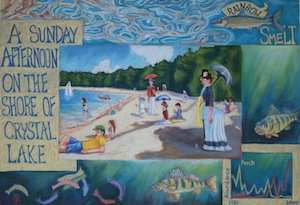Unique art and science project displayed at National Science Foundation
A series of paintings, quilts and other artworks developed through a collaboration between artists and ecologists in Wisconsin is on display at the headquarters of the National Science Foundation in Virginia.

The traveling exhibit, called “Drawing Water,” made up a major portion of a larger show called “Ecological Reflections.”
Deputy National Science Foundation director Cora Marrett, professor emerita of sociology at UW–Madison, attended the Feb. 29 opening for “Ecological Reflections.”
The collaboration for “Drawing Water” was born at UW–Madison’s Trout Lake Research Station, part of the science foundation’s Northern Temperate Lakes Long-Term Ecological Research network.
Artists and scientists occupy realms that seldom overlap, says Emily Stanley, a UW–Madison ecologist and principal investigator of the Long-Term Ecological Research, or LTER, project at Trout Lake.
“Going in to this project, we thought the collaboration would be a great way to communicate some of our scientific understanding about lakes and long-term change to a broad audience, and the overall interest and attention that the artwork has attracted has exceeded my expectations,” Stanley says.
Roadside kiosks in Northern Wisconsin featured some of the artworks, Stanley noted. But she adds that the collaboration worked in both directions.
“This art-science collaboration, and the beautiful art that resulted from our discussions, has also turned out to be surprisingly effective at engaging other scientists,” Stanley says. “I’ve had great scientific discussions with some of my LTER colleagues while we were standing in front of a quilt or a painting about Wisconsin lakes.”
Several of the artworks focus on the theme of change in the aquatic environment. For example, Terry Daulton’s “A Sunday Afternoon on the Shore” echoes “A Sunday on La Grande Jatte” by French painter Georges Seurat. Daulton’s pastel portrays generations of visitors to Crystal Lake, a popular vacation spot near Boulder Junction, to show that long-term ecological research involves a trip across time.
“Although visitors may not notice changes to the lake surface, invasive species and climate change can dramatically affect the health of the ecosystem,” Daulton explains.
The artworks from “Ecological Reflections,” which includes the “Drawing Water” show, will be displayed at the Ecological Society of America in Portland, Ore., Aug. 5 to 10, and at a meeting of the LTER scientists in Estes Park, Colo., Sept. 10 to 13.
A slide show of the artworks can be seen at http://www.news.wisc.edu/slideshows/46/slides/333.
Tags: arts, biosciences



